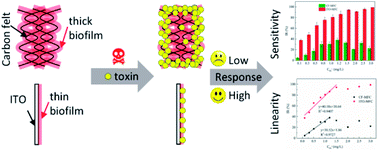Enhanced detection of toxicity in wastewater using a 2D smooth anode based microbial fuel cell toxicity sensor†
Abstract
As the biological recognition element of microbial fuel cell (MFC) toxicity “shock” sensors, the electrode biofilm is perceived to be the crucial issue that determines the sensing performance. A carbon felt and indium tin oxide (ITO) film anode were utilized to examine the effects of anodic biofilm microstructure on MFC toxicity sensor performance, with Pb2+ as the target toxicant. The carbon felt anode based MFC (CF-MFC) established a linear relationship of Pb2+ concentration (CPb2+) vs. voltage inhibition ratio (IR2h) at a CPb2+ range of 0.1 mg L−1 to 1.2 mg L−1. The highest IR2h was only 38% for CF-MFC. An ITO anode based MFC (ITO-MFC) also revealed a linear relationship between CPb2+ and IR2h at CPb2+ of 0.1 mg L−1 to 1.5 mg L−1 but better sensing sensitivity compared with the CF-MFC. The IR2h of ITO-MFC gradually approached 100% as CPb2+ further increased. The enhanced sensing sensitivity for the ITO anode possibly originated from the thin biofilm that resulted in the efficient exposure of exoelectrogens to Pb2+. The employment of 2D conductive metal oxide with a smooth surface as the anode was able to increase the MFC sensing reliability in real wastewater.



 Please wait while we load your content...
Please wait while we load your content...